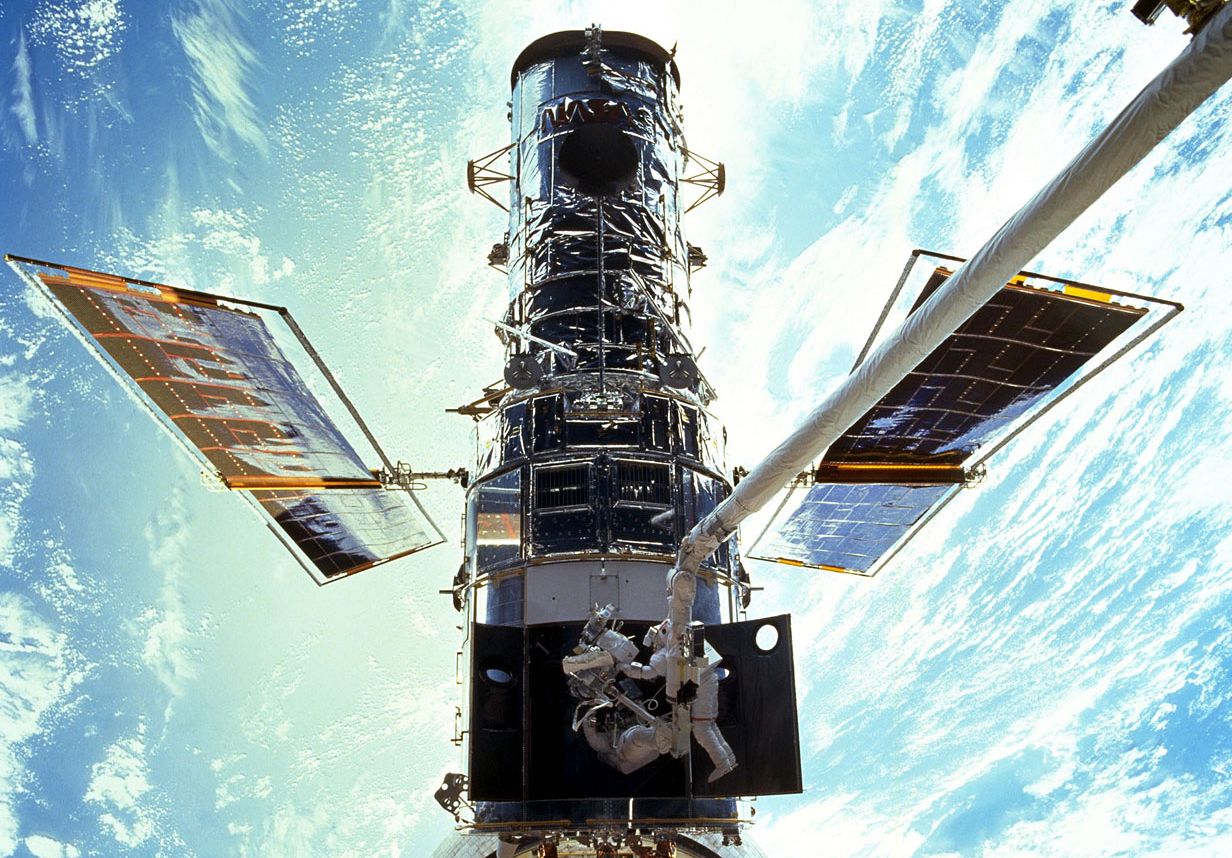
How Hubble Came About
The Earth's atmosphere is the bane of astronomers. A space telescope avoids frustrating problems such as cloudy and misty observing nights, the twinkling of stars even on clear nights and absorption of the ultraviolet and infrared parts of the spectrum.
The American Lyman Spitzer's plan for a space telescope came out in 1946 and lobbied for his idea for almost 30 years. In the 1970s NASA and the European Space Agency took up the idea and proposed a 3 metre space telescope.
- Funding began to flow in 1977 and it was decided to name the telescope after Edwin Powell Hubble (ext. link) who had discovered the expansion of the Universe in the 1920s. Although the Hubble Space Telescope was down-sized to 2.4 metres the project started to attract significant attention from astronomers.
- The precision-ground mirror was finished in 1981 and the assembly of the entire spacecraft was completed in 1985.
- Hubble was finally launched in 1990 and the tension built up as astronomers examined the first images through Hubble's eyes.
30 years of glorious discoveries!
The Hubble Space Telescope, a joint ESA and NASA project, has made some of the most dramatic discoveries in the history of astronomy. From its vantage point 600 km above the Earth, Hubble can detect light with 'eyes' 5 times sharper than the best ground-based telescopes and looks deep into space where some of the most profound mysteries are still buried in the mists of time. Let's follow Hubble's milestones in this timeline.
1990 – 1995
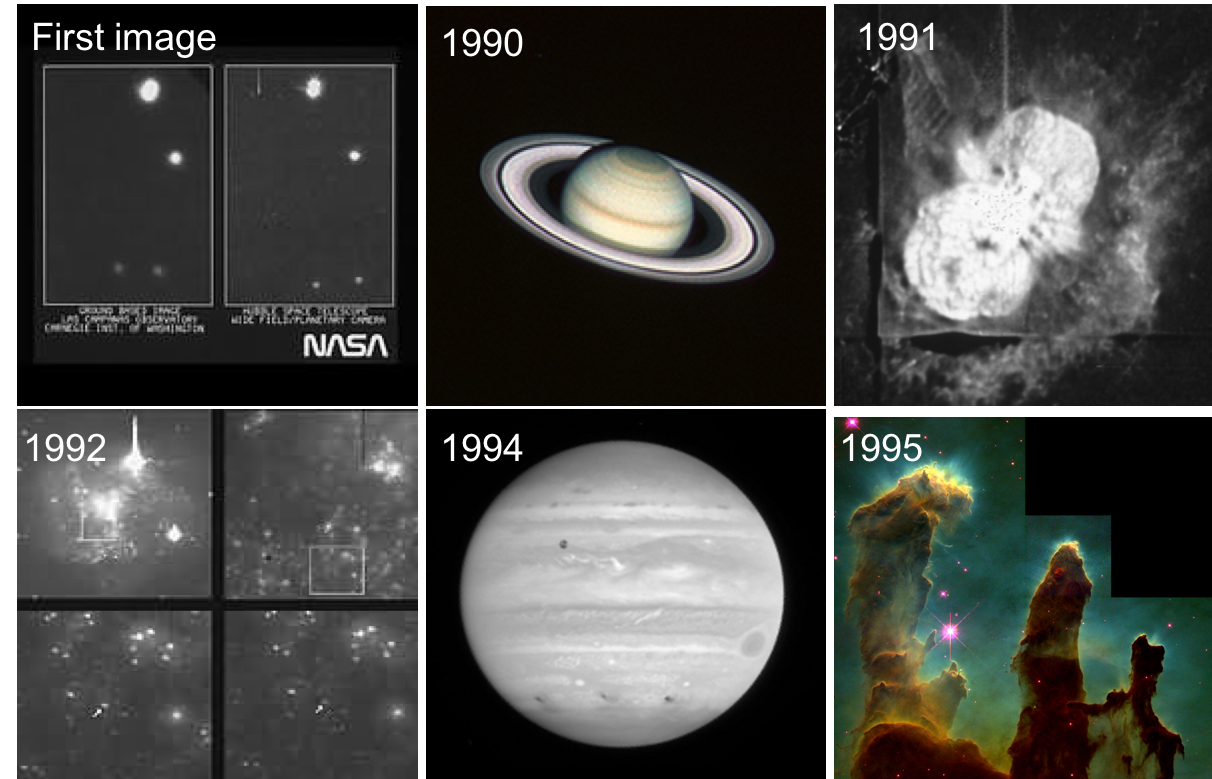
- Nearly one month after launch, NASA Headquarters, NASA’s Goddard Space Flight Center, and the Space Telescope Science Institute release the long-awaited first-light image from the Hubble Space Telescope. Taken to assist in focusing the telescope and made using Hubble's Wide Field/Planetary Camera (WFPC), the image shows part of a star cluster about 1,300 light-years from Earth.
- 1990: the HST's Wide Field and Planetary Camera (WF/PC) takes a cooler image of Saturn, when the planet was at a distance of 1.39 billion kilometers from Earth. The color in the image is reconstructed by combining three different pictures, taken in blue, green and red light (4390, 5470 and 7180 angstroms) (read more).
- 1991: Observations of a massive, unstable star called Eta Carinae, made with the Wide Field and Planetary Camera (WF/PC) aboard NASA's Hubble Space Telescope HST, reveal surprising and complex new structure in a dusty nebula surrounding the star. New details include a jet of material flowing away from the star and a regularly spaced set of wave-like features (read more).
- 1992: An international team of astronomers takes a major first step in redetermining the expansion rate of the universe. This rate, known as the Hubble Constant, is one of two critical numbers needed for making a precise determination of the size and age of the universe. How? Measuring the intrinsic brightness of Cepheid variable stars, hence their distance (read more).
- 1993: The space shuttle Endeavour is launched on 2 December to conduct the First Servicing Mission on Hubble. During the mission the corrective optics of COSTAR are installed which replace the High Speed Photometer.
- 1994: Hubble provides detailed observations of the comet Shoemaker–Levy 9 as it collides with the planet Jupiter (read more). In addition, by observing the galaxy M87 Hubble provides conclusive evidence for the existence of Supermassive Black Holes in the centres of galaxies (read more).
- 1995: Hubble takes the famous photo of the Eagle Nebula which later will be called “the pillars of creation" (read more).
1996 – 2000
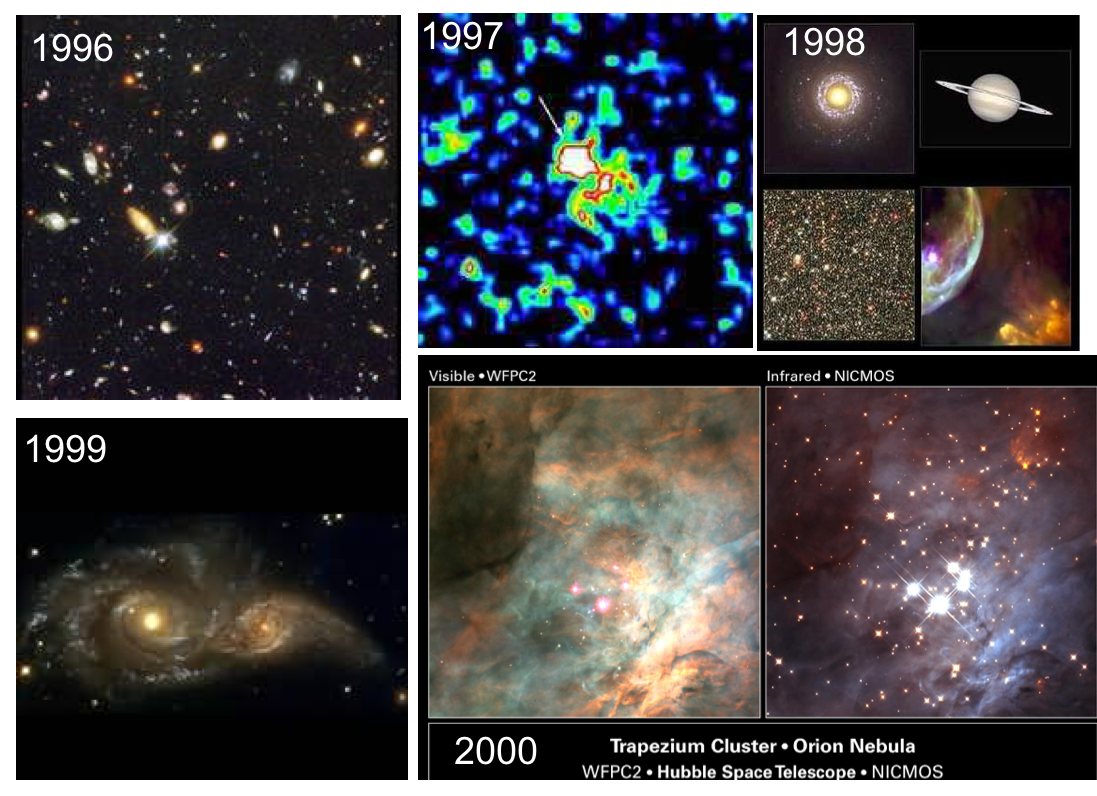
- 1996: the first Hubble Deep Field is revealed and allows astronomers to study galaxies in the early Universe (read more). In the same year Hubble resolves the host galaxies of quasars (read more).
- 1997: Servicing Mission 2 (STS-82) is launched on 11 February. The crew of the space shuttle Discovery replace the instruments FOS (Faint Object Spectrograph) and GHRS (Goddard High Resolution Spectrograph) with STIS (Space Telescope Imaging Spectrograph) and NICMOS (Near Infrared Camera and Multi-Object Spectrograph). Within 1997 Hubble also observes the visible afterglow of a gamma-ray burst in a distant galaxy (read more).
- 1998: the Hubble Heritage Program is created. A vibrant celestial photo album of some of NASA Hubble Space Telescope's most stunning views of the universe is being unveiled today on the Internet. This Technicolor gallery is being assembled by a team of astronomers at Hubble's science operations center, the Space Telescope Science Institute (STScI) in Baltimore, MD (read more).
- 1999: The Hubble telescope catches a cosmic dance between two spiral galaxies. Strong gravitational forces from the larger galaxy NGC 2207 have distorted the shape of its smaller dance partner,IC 2163, flinging out stars and gas into long streamers that extend 100,000 light-years toward the right-hand edge of the picture. Billions of years from now the two galaxies will become one, eventually (read more).
- 2000: Probing deep within a neighborhood stellar nursery, the Hubble Space Telescope uncovers a swarm of newborn brown dwarfs. The brown dwarfs are too dim to be seen in an image taken by the Hubble telescope's visible-light camera, while the near-infrared camera revealed about 50 of these objects throughout the Orion Nebula's Trapezium cluster, about 1,500 light-years from Earth (read more).
2001 – 2005
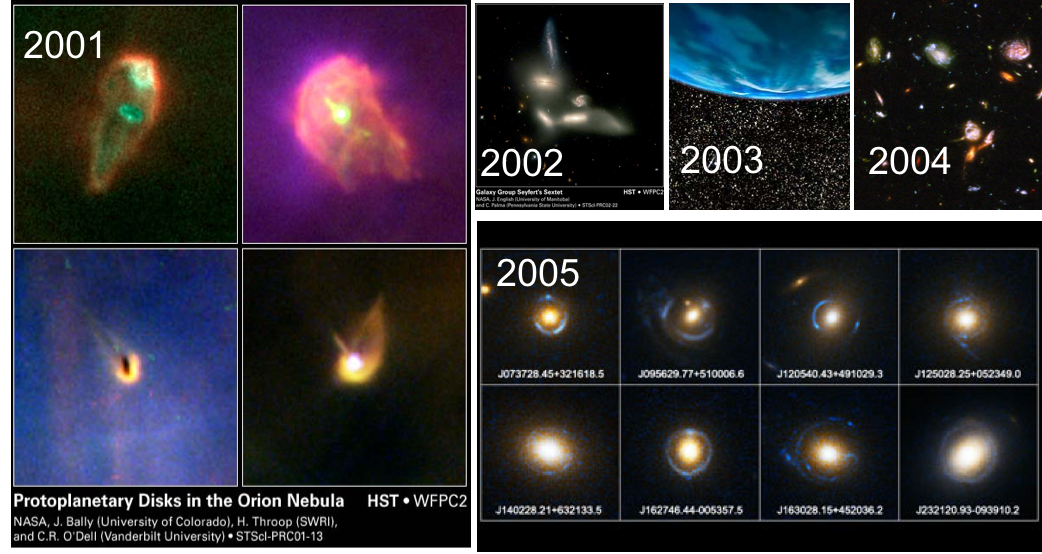
- 2001: Hubble is able to measure the elements on the atmosphere of the exoplanet HD 209458b (read more). Hubble also takes snapshots revealing astronomers the first direct visual evidence for the growth of planetary "building blocks" inside the dusty disks of young stars in the Orion Nebula, a giant "star factory" near Earth (read more).
- 2002: Hubble detects an icy object in the Kuiper belt at the edge of our Solar System which is larger than Pluto (read more). This discovery leads to a debate on Pluto's status as a planet. Hubble Space Telescope witnesses a grouping of galaxies, the Seyfert's Sextet, engaging in a slow dance of destruction that will last for billions of years (read more).
- 2003: Hubble Space Telescope precisely measures the mass of the oldest known planet in our Milky Way galaxy. At an estimated age of 13 billion years, the planet is more than twice as old as Earth's 4.5 billion years. It formed around a young, sun-like star barely 1 billion years after our universe's birth in the Big Bang (read more).
- 2004: The Hubble Ultra Deep Field is released allowing astronomers to look even further back in the time of the cosmos (read more). Another servicing mission is cancelled out of concern for shuttle safety and the power supply on STIS (Space Telescope Imaging Spectrograph) fails.
- 2005: Hubble identifies 19 new "gravitationally lensed" galaxies, adding significantly to the approximately 100 gravitational lenses previously known. Among these 19, they have found eight new so-called "Einstein rings," which are perhaps the most elegant manifestation of the lensing phenomenon (read more).
2006 – 2010

- 2006: Scientists using NASA's Hubble Space Telescope have found that, by using the class of ancient exploding stars (or supernovae) for tracking the cosmic expansion over most of the universe's lifetime, dark energy is not a new constituent of space, but rather has been present for most of the universe's history (read more).
- 2007: Hubble observations show that the dwarf planet Eris is bigger than Pluto (read more). A 3D-map, based on images by Hubble, showing the distribution of dark matter in the Universe is revealed (read more). Also in 2007 the power supply on the Advanced Camera for Surveys, one of Hubble’s key instruments, fails.
- 2008: The NASA/ESA Hubble Space Telescope takes the first visible light snapshot of a planet circling another star (read more). In the same year Hubble finds organic molecules on an extrasolar planet (read more) and the telescope’s 100 000th orbit around Earth is celebrated.
- 2009: Servicing Mission 4 (STS-125) is launched on 11 May. The astronauts install two new instruments, WFC3 (Wide Field Camera 3) and COS (Cosmic Origins Spectrograph) which make Hubble 100 times more powerful than when it was launched. During the servicing mission the damaged instruments are repaired, the gyroscopes and batteries are replaced, and the Soft Capture Mechanism as well as NBLs (New Outer Blanket Layers) are installed (read more).
- 2010: Hubble images reveal distant galaxies with likely redshifts greater than 8, showing the Universe as it was when it was less than a tenth of its current age (read more). Hubble also photographs a never-before-seen evidence of a collision between two asteroids (read more).
2011 – 2015

- 2011: Hubble makes its millionth observation, a spectroscopic analysis of the exoplanet HAT-P-7b. The 10 000th scientific paper using Hubble data is published (read more).
- 2012: Images taken by Hubble show seven primitive galaxies from a distant population that formed more than 13 billion years ago. The galaxies are seen as they were when the Universe was less than 4% of its present age. Later in the year even that record is broken as Hubble finds an object back from a time when the Universe was only 3% of its present age, only 470 million years after the Big Bang (read more). Hubble observations also lead to a new class of exoplanet (read more).
- 2013: Hubble is also used in this year to determine for the first time the true colour of a planet orbiting another star (read more) and finds water vapour erupting off the surface of Jupiter’s moon Europa (read more).
- 2014: Hubble becomes the first telescope ever to observe an asteroid disintegrating (read more) and it reveals the most detailed weather map for an exoplanet ever (read more).
- 2015: Hubble observes, for the first time, four images of a distant exploding star arranged in a cross-shaped pattern by the powerful gravity of a foreground galaxy embedded in a massive cluster of galaxies (read more). It also celebrates its 25th year in orbit with celebrations across the globe (read more) !
2016 – 2020
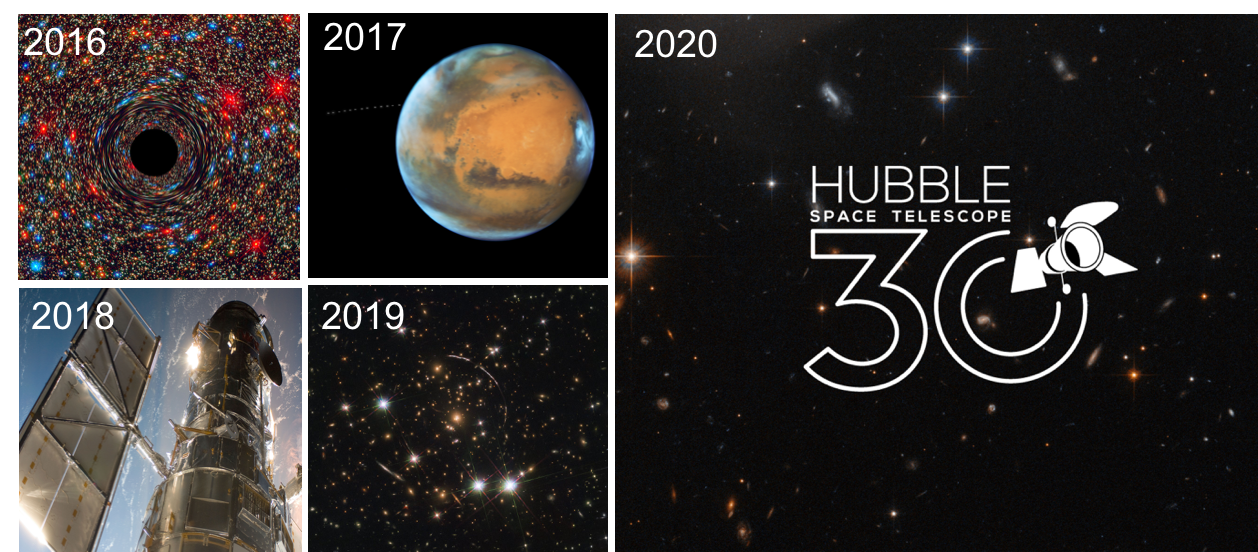
- 2016: Hubble discovers supersized black hole residing in the center of a massive elliptical galaxy, NGC 1600, located in the crowded Coma galaxy cluster about 330 million light-years away (read more). The same year thanks to ultra-sharp images from the Hubble Space Telescope, astronomers could identify a Saturn-mass planet circling two diminutive, faint stars in a tight orbit around each. The system, called OGLE-2007-BLG-349, resides 8,000 light-years away (read more).
- 2017: Hubble photographed the glow from the collision of two neutron stars shining within the galaxy NGC 4993 at a distance of 130 million light-years. Hubble also obtained an infrared spectrum that may yield signs of exotic, radioactive elements (read more). In the same year, the sharp eye of Hubble Space Telescope has captured the tiny moon Phobos during its orbital trek around Mars (read more).
- 2018: Hubble returns to conducting science after successfully recovering a backup gyroscope that had replaced a failed gyro three weeks earlier. Originally required to last 15 years, Hubble has now been at the forefront of scientific discovery for more than 28 years (read more). Hubble and the European ESA/Gaia space observatory in synergy for the most precise measurement to date of the universe’s expansion rate: Hubble constant (read more).
- 2019: Astronomers using the NASA/ESA Hubble Space Telescope have observed a galaxy in the distant regions of the Universe which appears duplicated at least 12 times on the night sky. This unique sight, created by strong gravitational lensing, helps astronomers get a better understanding of the cosmic era known as the epoch of reionisation (read more).
- 2020: NASA/ESA Hubble Space Telescope celebrates 30 incredible years in orbit!